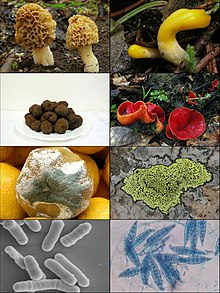Dikarya is a subkingdom of Fungi that includes the divisions Ascomycota and Basidiomycota, both of which in general produce dikaryons, may be filamentous or unicellular, but are always without flagella. The Dikarya are most of the so-called "higher fungi", but also include many anamorphic species that would have been classified as molds in historical literature.[1] Phylogenetically the two divisions regularly group together.[3][4] In a 1998 publication, Thomas Cavalier-Smith referred to this group as the Neomycota.[5]
| Dikarya | |
|---|---|

| |
| Diversity of Basidiomycota, which includes (clockwise from top-left): fly-agaric (Amanita muscaria), Dacrymyces palmatus, porcini (Boletus edulis), Uromyces rumicis (in the Uromyces genus of rust fungi), Meredithblackwellia eburnea, bamboo mushroom (Phallus indusiatus), azalea gall (Exobasidium vaccinii), and red cage (Clathrus ruber) | |

| |
| Diversity of Ascomycota clockwise from top-left, which includes common morel (Morchella esculenta), Neolecta vitellina, scarlet elfcup (Sarcoscypha austriaca), Rhizocarpon, Microsporum canis, fission yeast (Schizosaccharomyces pombe), Penicillium, and black truffle (Tuber melanosporum) | |
| Scientific classification | |
| Domain: | Eukaryota |
| Kingdom: | Fungi |
| Clade: | Symbiomycota |
| Subkingdom: | Dikarya Hibbett, T.Y.James & Vilgalys (2007)[1] |
| Divisions | |
| Synonyms[1][2] | |
|
Carpomycetaceae Bessey (1907) | |
Phylogeny
edit| Phylogeny of the Dikarya and upper-level taxa in Kingdom Fungi.[1] |
The 2007 classification of Kingdom Fungi is the result of a large-scale collaborative research effort involving dozens of mycologists and other scientists working on fungal taxonomy.[1] It recognizes seven divisions within the Fungi, two of which—the Ascomycota and the Basidiomycota—are contained within a branch representing subkingdom Dikarya. The cladogram depicts the major fungal taxa and their relationship to opisthokont and unikont organisms. The lengths of the branches in this tree are not proportional to evolutionary distances.
Sexual reproduction
editThe phylum Ascomycota, or sac fungus, is characterized by formation of meiotic spores called ascospores enclosed in a special sac called an ascus. The genetic components for sexual reproduction appear to be produced by all members of this group.[6]
The phylum Basidiomycota can be divided into three major lineages: mushrooms, rusts and smuts. Fusion of haploid nuclei (karyogamy) occurs in the basidia, club-shaped end cells. Shortly after formation of the diploid cell, meiosis occurs and the resulting four haploid nuclei migrate into four, usually external cells called basidiospores.
Adaptive function
editSexual reproduction has been proposed to have evolved in both the Ascomycota and Basidiomycota as an adaptation for repair of DNA damage via homologous recombination under stressful conditions.[6]
See also
editReferences
edit- ^ a b c d e Hibbett, D.S.; et al. (March 2007). "A higher level phylogenetic classification of the Fungi". Mycological Research. 111 (5): 509–47. CiteSeerX 10.1.1.626.9582. doi:10.1016/j.mycres.2007.03.004. PMID 17572334. S2CID 4686378.
- ^ Hibbett, DS; Blackwell, M; James, TY; Spatafora, JW; Taylor, JW; Vilgalys, R (July 2018). "Phylogenetic taxon definitions for Fungi, Dikarya, Ascomycota and Basidiomycota". IMA Fungus. 9 (2): 291–298. doi:10.5598/imafungus.2018.09.02.05. PMC 6317587. PMID 30622884.
- ^ Lutzoni, F.; et al. (2004). "Assembling the fungal tree of life: progress, classification, and evolution of subcellular traits". American Journal of Botany. 91 (10): 1446–80. doi:10.3732/ajb.91.10.1446. PMID 21652303.
- ^ James, T.Y.; et al. (2006). "Reconstructing the early evolution of Fungi using a six-gene phylogeny" (PDF). Nature. 443 (7113): 818–22. Bibcode:2006Natur.443..818J. doi:10.1038/nature05110. PMID 17051209. S2CID 4302864. Archived from the original (PDF) on 2007-06-11.
- ^ Cavalier-Smith, T. (1998). "A revised six-kingdom system of life". Biological Reviews. 73 (3): 203–66. doi:10.1111/j.1469-185X.1998.tb00030.x. PMID 9809012. S2CID 6557779.
- ^ a b Wallen RM, Perlin MH (2018). "An Overview of the Function and Maintenance of Sexual Reproduction in Dikaryotic Fungi". Front Microbiol. 9: 503. doi:10.3389/fmicb.2018.00503. PMC 5871698. PMID 29619017.
External links
edit- AFTOL classification at Dave Hibbett's site Archived 2021-04-23 at the Wayback Machine